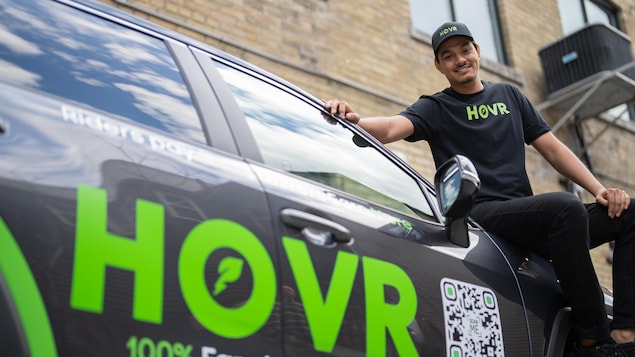- Home
- Economy
Can a Toronto-based ride-hailing startup compete with Uber and Lyft?

Harrison Amit, CEO of the new ride-hailing app Hovr, hopes to compete with Uber and Lyft and win over drivers with a different pay structure. Here he poses with the company's promotional car.
Photo: Radio-Canada / Chris Langenzarde
Ride-hailing company Hovr says fair pay for drivers will power their business
Harrison Amit is leading a small startup with a big idea.
The vision for the company is helping over 10 million drivers,
said the 28-year-old CEO of Hovr (pronounced Hover).
The Toronto-based ride-hailing company launches today, and will service the city and surrounding suburbs.
Amit's goal is to make the company a national brand within a year and go way beyond that.
The question is whether this young entrepreneur compete with the global giant Uber, which has a 15-year head start and had 150 million active monthly users (new window) in Q4 2023 (including Uber Eats customers), or Lyft, which was founded 12 years ago and had 22 million active monthly riders (new window) in Q4.
Hovr's yet to provide a single ride, but Amit believes his company's approach could shake up the ride-hailing industry because of how it will pay drivers.
Our tagline at Hovr is 100 per cent fare is 100 per cent fair. And what that means is that the drivers take home 100 per cent of the fare from every ride that they receive.
It's a play on words, but also a strategic play, setting Hovr apart from the giants it's up against.
What 100 per cent of the fare means
Amit says Hovr will appeal to drivers because instead of taking a percentage of the total fare on every trip to turn a profit like Uber and Lyft do, Hovr will charge a $20 monthly membership fee to work for the service.
That price is an introductory rate that Amit says will rise as the business grows, but a fixed cost means drivers don't pay more for working more.
That's how Hovr lets drivers keep 100 per cent of the fare.
Hovr says it will make the costs of each ride transparent, giving riders a bill that shows the fare or driver's pay (the base rate, kilometres and time), and includes what the passenger is being charged for insurance, city fees, a transaction fee plus a $1 platform fee
from the company.
Amit says the 100 per cent fair slogan has helped sign up 5,000 drivers and 25,000 potential customers, through word of mouth, social media and a few billboards in downtown Toronto.
Milton Brady, a former cabbie who's been with Uber for four years, said he couldn't wait to sign up for Hovr.
Hovr is a knight in shining armour,
he said.
Brady says the industry needs more competition to make things better for drivers, and that Hovr's pay model would give drivers a chance to actually build some kind of economical stability in their lives.
Ride-hailing ripe for disruption?
In Amit's view, the ride-hailing business is due for a shake-up, like the taxi business was upset by Uber when it arrived.
We're entering a market that is ripe for disruption,
he said, It's riddled with dissatisfaction, on both sides from the riders and the drivers.
Complaints about surge pricing (new window) and service (new window), a tax investigation (new window) and unionization efforts (new window) are all issues the industry has faced.
As an industry, ride hailing is in need of change,
said Kam Phung, an assistant professor with the Beedie School of Business at Simon Fraser University in Vancouver.
We know that it is riddled with problems and challenges, specifically on the workers' rights fronts.
On Valentine's Day this year, a driver protest and strike (new window) was staged in several cities around the world as some gig workers logged off their apps, refusing work to bring attention to their pay and working conditions.
In Toronto, a report (new window) from Ridefair Toronto and the Rideshare Drivers Association of Ontario (RDAO) estimated many drivers were making less than minimum wage after expenses.
More protests (new window) were staged this week in several cities (new window) to line up with International Workers' Day (new window) on May 1, with Toronto drivers protesting at the city's Union Station and Pearson Airport.
WATCH | More on the Valentine's Day strike:
Toronto ride-hailing and food delivery drivers strike for better pay, working conditions
Some local drivers with companies like Uber, Lyft and DoorDash are striking Wednesday to call for higher wages. In a statement, Uber said the vast majority of drivers are satisfied,
but drivers told CBC Toronto many of them are being paid less than $10 an hour.
What Uber and Lyft say about the business and fair pay
Both Uber and Lyft see the ride-hailing industry as thriving and report positive trends in their quarterly reports.
Both have also said they feel competition is good for consumers and drivers.
Uber Canada told CBC News in a statement the vast majority of drivers are satisfied,
and in the Toronto area, for example, are making $33.35 during engaged time per hour before tips.
The company also said it believes drivers should earn a guaranteed minimum wage,
and it will comply with new laws in Ontario and BC that enforce such a standard.
In an interview with CBC News, Lyft CEO David Risher said roughly speaking, out of every dollar that you as a rider pay, Lyft earns about nine cents.
He said the remaining 91 cents is split between insurance and other fees, but most of it goes to the driver.
It's in our best interest that drivers actually get paid more, because it means more people are on the platform,
he said.
A global brand?
Amit says Hovr is positioning itself for the global stage,
but interest from drivers will be the key to the company's growth.
He hopes drivers who are excited about Hovr and working for Lyft or Uber will convince their passengers to switch over, as well.
I don't believe there's any level of brand loyalty, it's more of a forced relationship with these companies, due to a lack of options.
Phung believes Hovr could grow quickly because there's a demand from some consumers for gig-economy models that actually allow workers to have a fair wage, and contribute to the creation of a just and equitable society.
But, he added, the reality of competing against big multinationals means the company could be in for a bumpy ride.
James Dunne (new window) · CBC News ·




